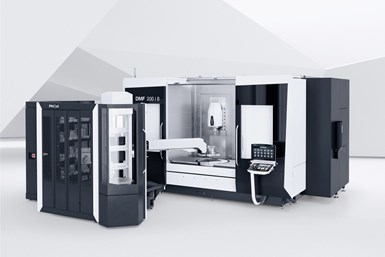DMG MORI's DMF 200|8 Compatible with Long Mold Inserts
DMG MORI’s DMF 200|8 offers DMG MORI’s customary stability for traveling column machines while enlarging the work area for new die and mold possibilities.

DMG MORI’s (Hoffmann Estates, Ill.) DMF 200|8 five-axis traveling column machine offers a larger work range than ever before, opening new possibilities for machining complex components. “With a rigid table measuring 2,300 x 850 mm and traverse paths of 2,000 x 800 x 850 mm, the DMF 200|8 offers users in die and mold and aerospace sufficient scope to flexibly machine even long structural components or mold inserts,” Markus Rehm, managing director of DECKEL MAHO Seeback, says.
The working area is over 50% larger than DMG MORI’s predecessor model, and the table load is 2,000 kg. A redesigned tool change behind the work table enables use of the full clamping surface. The DMF 200|8 is also compatible with 400 mm-long tools.
Swift, high-precision machining
DMG MORI upholds its traveling column machines’ reputation for stability with the DMF 200|8’s cantilevered Y-axis, which the company says ensures constant machine rigidity over the entire travel path. The X-axis’ three linear guides reinforce the machine’s stability and support precise and productive machining. Even with the Y-slide fully extended, DMG MORI promises access to maximum spindle power without the machine swinging up. Extensive standard cooling measures ensure high thermal long-term accuracy even with small tolerances, while direct-driven ball screws in the Y- and Z-axes support high-quality surface finishes.
The DMF 200|8 travels at rapid traverse rates of up to 50 m/min as standard, reaching 80 m/min with the optional X-axis linear drive. The B-axis milling head shows five-axis machining flexibility through its 6,000 Nm maximum clamping torque and swivel range of +/- 120 degrees. An extensive modular spindle system rounds off the equipment variety.
Automated and digitized
DMG MORI’s DMF 200|8 comes standard with CELOS’ latest version to prepare users for digitized production, while offering a PH Cell pallet as an interface for automated production.
Related Content
-
Tips for Tackling Mold Design, Machining, Cutting Tool and Wear Challenges
Tips for tasks ranging from reducing risk in part design and taking advantage of five-axis machining to refining cutting tool performance and reducing wear with guiding and centering systems.
-
How to Generate the Ideal Tool Path for High-Level Accuracy and Finish
When a mold builder can’t compromise part accuracy and surface finish, CAM software with specialized programming strategies is essential.
-
Precision Meets Innovation at IMTS 2024
After attending IMTS, it's clear that the integration of advanced technologies is ready to enhance precision, efficiency and automation in mold manufacturing processes. It’s a massive event, so here’s a glimpse of what the MMT team experienced firsthand.
















